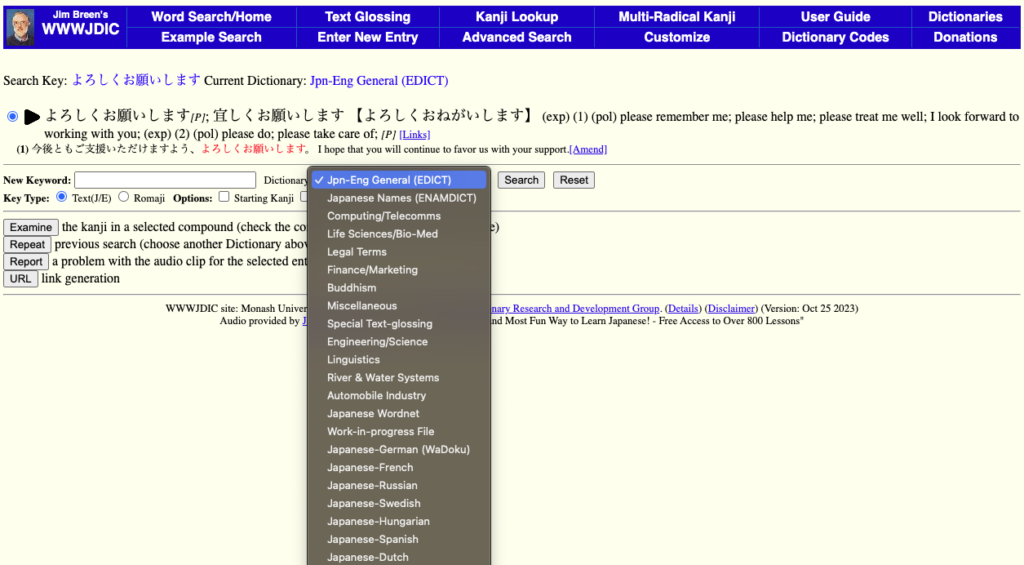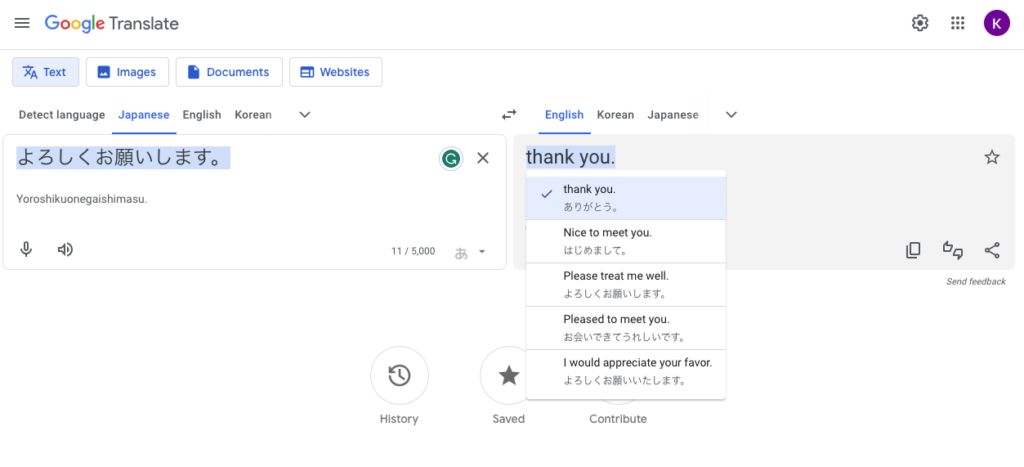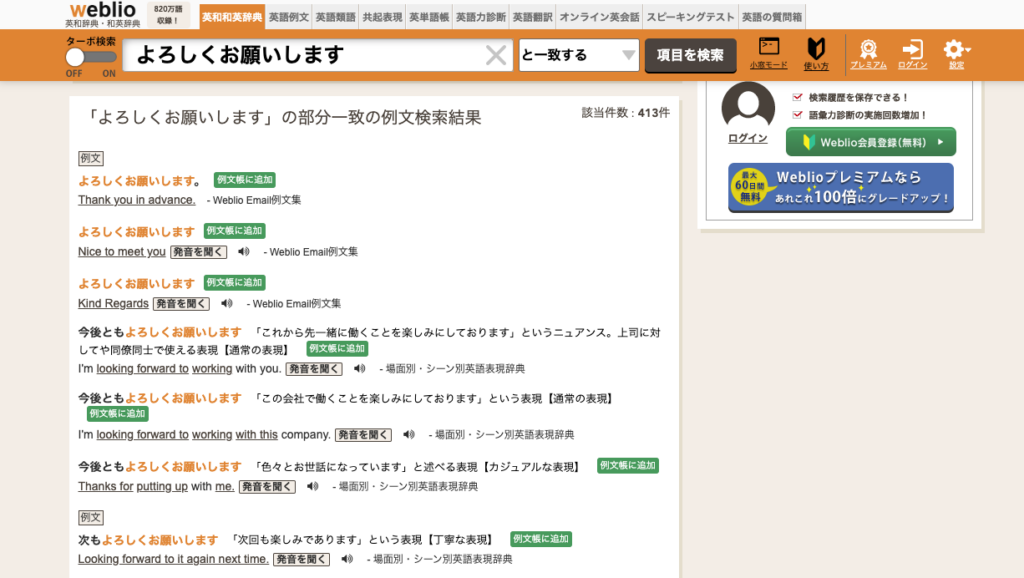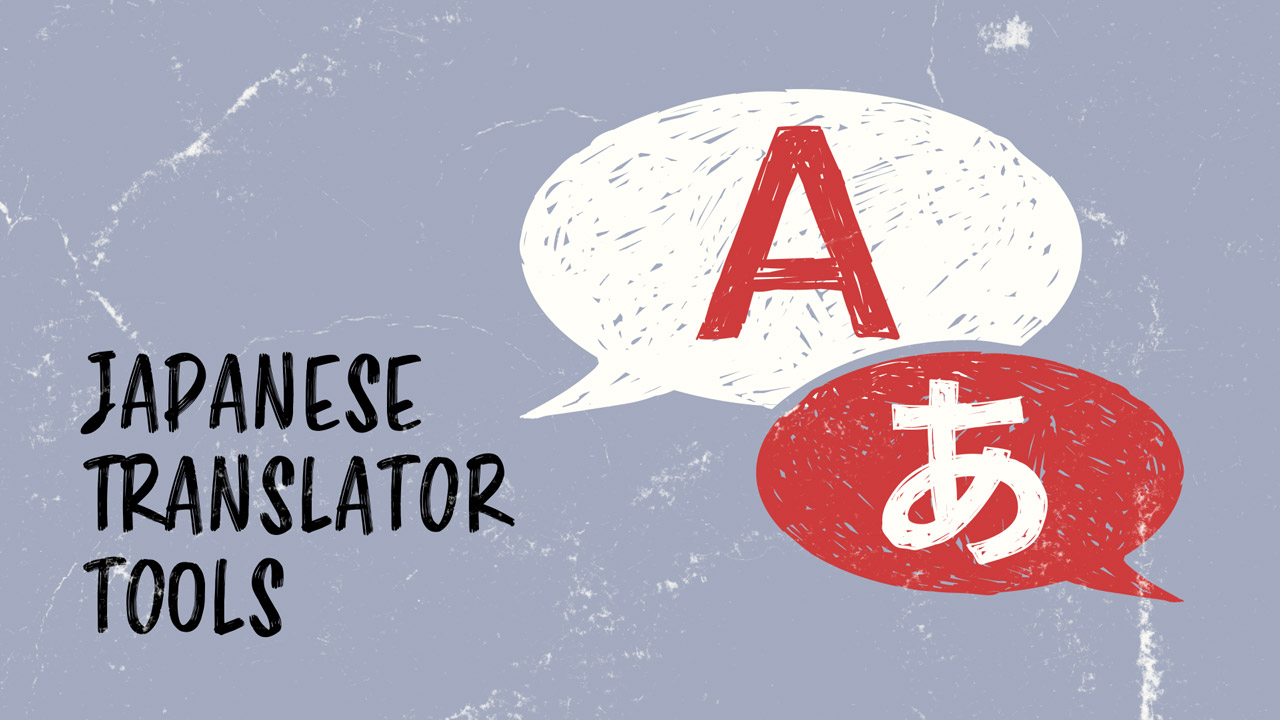The 9 Best Japanese Translator Tools: Websites, Apps, and Dictionaries
Whether you’re simply building your own language skills or doing professional translation work, picking the best Japanese translator can be tricky. Which ones are the most accurate? Which ones have the specialized vocabulary you need? And how reliable are AI and automatic translators?
I’ve worked in Japanese translation in so many different contexts over the years, both in Japan and the US. Professionally, I’ve dabbled in a variety of works, including translating and interpreting TV shows and movie subtitles, executive-level meetings of all levels at a manufacturing company, political news coverage, and cultural heritage sites for tourism.
In this article, I’ll introduce you to some of the most popular translator websites and apps. I’ll also provide guidance on how to find specialized dictionaries and translators if you need them. So let’s get to it!
Table of contents
- The Best Japanese Translation Dictionary for English Speakers: WWWJDIC (and Variants)
- The Best Japanese Machine Translation Site: Google Translate
- The Up and Coming Japanese Machine Translator: ChatGPT
- The Best Japan-Based Translator: Weblio
- CATs: Computer Assisted Translation Tools
- Finding Other Specialized Japanese Translators
- Human Translators: The Only Way to Get the Nuance Right
- Ready to 翻訳 ( Hon’yaku / Translate)?
The Best Japanese Translation Dictionary for English Speakers: WWWJDIC (and Variants)
If you’re looking for a good Japanese translator app or website, look no further than those based on the Australian academic Jim Breen’s amazingly thorough project WWWJDIC. This is a Japanese-English and English-Japanese dictionary – and much, much more!
You may know this website by another name. For example, WWWJDIC powers popular dictionaries such as Jisho.org, the imiwa? app, and the Yomiwa app.
(While most Japanese learners I’ve met prefer the interface of Jisho.org, I’m quite loyal to the WWWJDIC website. Maybe I’m a bit of a purist. But it doesn’t matter – either site will basically allow you to do all of the exciting things I’m about to tell you!)

The main dictionary has about 180,000 entries – and that’s a lot! Massive, really! Many vocabulary and phrase entries show multiple ways to read and write the word (for example, if the same word might have multiple possible pronunciations or kanji) and example sentences. This way, you can see how words are used in context or how they might be translated in different ways.
WWWJDIC even includes translations of specialized terminology, such as those in fields such as medicine, engineering, law, and Buddhism. Amazing!
WWWJDIC also has an extensive Japanese surname database. This is incredibly useful since Japanese names often break or bend the rules for kanji readings!
Speaking of which, WWWJDIC also has an extensive overall kanji database. It can even help you break down and identify kanji based on the JLPT (Japanese Language Proficiency Test) or the most commonly used kanji, for example.
While WWWJDIC isn’t a “translator” at heart, it is an essential tool for anyone working on a Japanese translation. You will always need a good dictionary. I also include it for two more reasons:
First, it has some translation entries for set phrases or idiomatic expressions. This is a great resource for identifying kotowaza, or Japanese proverbs, which might not seem obvious when put into a translation machine!
Also, it also has a handy “text glossing” feature. On this page, you can input a lengthier text, and it will help you identify and translate core words and grammar patterns. This is incredibly helpful if you are translating a passage and don’t want to look up each word one at a time. (This is called “text reading assistance” on Jisho.org, but I honestly feel like WWWJDIC does a better job at this one.)
Notable competitors:
- Honestly, for English speakers, WWWJDIC has none in terms of English-Japanese and Japanese-English dictionaries. It powers many websites and apps, so you can choose which one you like the best. Its only real competition is some websites for Japanese speakers like Weblio, which I explain in a later section.
The Best Japanese Machine Translation Site: Google Translate
Over the last several years, Google Translate has become a very accurate Japanese translator. It’s available as both a website and app for iOS and Android.
Google has made some great investments in its translation abilities between English and Japanese, and it has paid off! I remember the days when it would just translate word for word and come up with gibberish. Now, it can translate even complex or relatively nuanced passages!

Not only can it translate relatively long passages very quickly, but it’s also quite accurate! The machine voices can produce audio that sounds relatively human, and the app can also translate text from your camera in real time.
Keep in mind that there are some things Google Translate (and indeed, any machine translation) still struggles with regard to Japanese translation. Since Japanese is a very context-dependent language – for example, it often leaves out the subject of a sentence – there are simply things machine translators won’t get right.
It also works better with structured language. For example, in my experience, it translates news articles (which are often written in quite clear language) better than colloquial speech (which might be the most context-dependent of all)!
So, always double-check the translation it produces. It doesn’t always understand nuances or context!
Notable competitors:
- DeepL is the main competitor for Google Translate. It can translate emails and documents, like PowerPoint files, and offers some CAT tools (or Computer Assisted Translation tools, as discussed a bit further down). However, most of its features are in its paid version, so it’s not as accessible as Google Translate.
- Those loyal to Microsoft may want to use Bing’s Microsoft Translate, but honestly, it’s just not as developed for English-Japanese pairings.
The Up and Coming Japanese Machine Translator: ChatGPT
You’re probably wondering about how AI is going to change the landscape of the Japanese translation world. Honestly, so am I! Even a lot of professional CAT tools and other machine translators are now using AI.
AI and what it can do is changing constantly. As of now, ChatGPT can translate between Japanese and English. Here’s the lowdown of how the free version of ChatGPT does currently.

Pros:
- You can interact with it and give it context to the translation. This is different from Google Translate (although sometimes Google Translate allows you to choose from multiple translation options). This is very important in highly contextual languages such as Japanese, since the meaning of a sentence might vary depending on the context.
- If you think something is wrong in the translation it produces, you can give it feedback and have it edit its translation. This includes asking it to revise things like its vocabulary, fluency, or accuracy.
- Like Google Translate, it’s quick! Enough said.
Cons:
- While paid pro versions are becoming more specialized with translation, ChatGPT was not made with translation explicitly in mind, like Google Translate. It relies on patterns of information it’s fed, and sometimes it produces inaccurate or inappropriate content. Since Google Translate is putting a lot of emphasis on Natural Language Processing, it still might have a slight edge in some cases.
- In relation, ChatGPT’s output is still highly reliant on how you prompt it. Therefore, depending on what you input, the quality of its output may vary significantly. This may be a challenge until you find the right prompting method for your needs.
- While ChatGPT can work with complicated and long translations, it tends to work well with less complex translations. Since it was made with translation in mind, Google Translate still seems to have an edge with longer passages.
So the bottom line here is that ChatGPT is an emerging translation tool. It is promising and worth comparing with Google Translate, but definitely check out our warnings about machine translation later on in the article!
The Best Japan-Based Translator: Weblio
I’ve talked about dictionaries made by native English speakers translating into Japanese. It’s worth mentioning the reverse – dictionaries made by native Japanese speakers translating into English!
Weblio is the winner here. It is a comprehensive Japanese-English pair dictionary made for Japanese native speakers. Like WWWJDIC, it also has a lot of specialized terminology.
Unlike the above, Weblio mostly acts as a dictionary of English words, explaining their meanings and nuances in Japanese. This makes it somewhat more useful for native Japanese speakers translating to or from English. You’ll also need to be comfortable navigating a website in Japanese to use it.
But there’s a part of the website that’s incredibly useful for English-native (or non-Japanese native) speakers, too.
By far, the most useful tool of this site is its ample example sentences. By searching for a key term or phrase, you can usually find several if not hundreds of example phrases and sentences with that word in use, translated into both English and Japanese. As I talked about in a previous section, this is incredibly helpful for seeing how words and nuances are conveyed in context!
The sentences and phrases usually differ from what’s on WWWJDIC, so it’s worth having a couple of dictionaries and translators at hand.

Notable competitors:
- Eijiro (英辞郎) is in my mind Weblio’s main competitor. Eijiro is a tool developed for Japanese speakers translating content into English. Like Weblio, its main sticking feature is its wealth of example sentences and phrases. I actually personally find its example sentences easier to search through and more robust than Weblio.
The downside is that whereas this website used to be free, accessing most of the example sentences now requires a subscription. That’s why Weblio wins this category, since it’s still free.
CATs: Computer Assisted Translation Tools
Now, if you are a professional Japanese translator, you might want to invest in a CAT, or a Computer Assisted Translation, tool. These are widely used by translators to enhance efficiency and maintain consistency in their work.
They often offer features like translation memory, localization glossaries, terminology management, collaborative translation, and quality assurance checks. By storing and streamlining translation information, they can help automate the translation process for the human translator.
These can be important if you are translating a big project, such as a novel or a television series, and need to translate names and terms consistently throughout. This is especially so if multiple people are working on the same project!
For example, I worked on a translation of a Japanese fantasy anime series with another translator (whom I had no direct interaction with and couldn’t discuss terms). We were translating subtitles for the same show but different episodes at the same time. We had to make note of how we translated names, places, and catchphrases in a shared spreadsheet to make sure we both used the same translation consistently. It was easy to mess up, and quite a headache! Having a CAT tool could have helped with these issues.
With the rapid developments of AI, CAT tools are changing at a very quick pace, including pricing. There are also so many on the market it’s difficult to select which one is the best over others. For example, DeepL provides many of the CAT tools above. So it’s best for you to look at what’s on the market and decide what the right one is for your (and possibly your team’s) needs. For a starting point, Benny talks about some in his article about how to become a location-independent freelance translator!
Finding Other Specialized Japanese Translators
When working as a Japanese translator, there are relatively few resources geared for native English speakers. Sometimes you might not find the right specialized dictionary, no matter how hard you search for it in English.
For example, WWWJDIC doesn’t have a significant repository of accountancy words and phrases. This is quite a difficulty if you need to translate or learn how to translate accounting!
Actually, sometimes you might have the best luck looking for Japan-based translation websites or dictionaries meant to support Japanese translators working with English. Weblio might have the phrases you need in its database, but in case it doesn’t, you can do a targeted internet search.
For example, the term “to close an account” means something different in an accounting department at a company compared to its use at a bank. In the former context, it’s a specialized accountancy phrase related to processing financial records (one possible translation is 計算を締め切る, keisan wo shimekiru). In the latter context, it’s completely different and something an average citizen might do – close a bank account (口座を閉じる, koza wo tojiru). You’ll likely find a translation for the latter in dictionaries. What if you don’t know the former?
You can go to your preferred search engine and type in “close accounts” with vocabulary related to the field you are translating in, such as 経理部 (keiribu, “accounting department [of a company]”). You might find some blogs or less-known websites with the specialized translations you need on Japanese websites. AI might also be increasingly helpful for this.
It might also be worth checking Japanese bookstores, since they often have very useful physical dictionaries of specialized fields. These are often to help Japanese employees learn English phrases for their international work environments.
For example, Toyota has streamlined a lot of its translations of its philosophy and work processes for its global hubs and suppliers. When I worked as a translator at one, I found this book to be very helpful.
So it’s worth looking around at multiple sources to find the right specialized translation assistance tools for you!
Human Translators: The Only Way to Get the Nuance Right
Although machines are now becoming more and more accurate Japanese translators, human translators are still very important. This is because AI still has no way to fully understand the context, nuances, and complexity of human interaction. And not understanding your target audience’s language and culture well can cost your business millions!
This is especially important when doing localization projects. These go beyond just direct translation. Localization is the adaptation of content to the cultural and contextual expectations of the target audience. It considers factors such as regional differences, cultural sensitivities, and user preferences. So it’s like combining translating, copyrighting, and editing of the content for the intended culture.
All in all, AI might be able to help with the direct translation, but humans are still absolutely necessary for the most accurate translations and localization! After all, not all accurate translations are direct.
Ready to 翻訳 (Hon’yaku / Translate)?
So if you are going to do Japanese translation, you will probably use a mix of the above tools! Machine translations can often quickly give you an idea of the meaning of the sentence, and dictionaries will help you understand the nuances of words. It’s the human’s job to put everything together.
With these tools, you should be ready to get started with accurate Japanese translations. Good luck!



Social